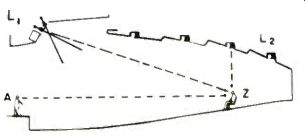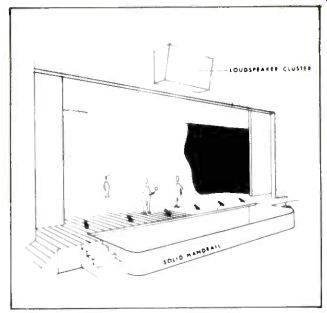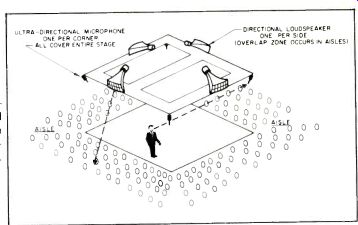by DAVID L. KLEPPER [ Senior Consultant, Bolt Beranek and Newman, New York, N.Y. ]
THE SOUND-REINFORCEMENT system is one of a number of electroacoustic systems that is required in the design of a performing arts hall. Any electronic reinforcement system is intimately involved in the overall acoustical design of the hall.
However, all systems of any type must be matched to the hall acoustically as well as matched to the program. Planning any sound system requires consideration of what it is supposed to do both acoustically and in terms of communication.
Need and Purpose. There is no stock solution for every auditorium. Not all spaces require reinforcement systems.
We were recently asked why we did not include a sound reinforcement system in our estimates for a certain 300-seat theater. The reason was there was apparently no particular need for a sound reinforcement system for that theater. Such theaters as the Tyrone Guthrie in Minneapolis and the new Alley Theater in Houston, Texas, with approximately 800 seats, do not have any need for a sound reinforcement system; they are used by resident theater companies and the acoustics are so designed that electronic reinforcement is unnecessary. Let us consider a number of different performing-arts facilities to determine whether sound systems are required and for what possible uses.
(1) A small outdoor-music facility, perhaps seating 1000 people with a well-designed acoustical band-shell. We might say no electronic amplification is required for this particular facility if used just for orchestra and band music.
(2) A large outdoor music facility, perhaps located in a park in the middle of a city with attendant traffic and aircraft noises. Sound reinforcement would be required for practically all activities in this facility.
(3) A typical concert hall of perhaps 1500-3000 seats. Sound reinforcement is not provided for orchestral music; perhaps not even for a soloist.
It is provided for a narrator speaking with the orchestra and for announcements. Occasionally it is provided for amplification of very weak instruments when requested by the music director.
Harpsichord amplification is an example, although harpsichords are available that can carry the 1500 to 3000 seat hall. In any case, the sound reinforcement system should be planned around these specific uses.
(4) A multi-purpose performing-arts center, a theater-concert hall-auditorium. This is the most typical college, university and municipal performing-arts facility. Speeches and narration with an orchestra will require amplification in this hall. It has become conventional to provide sound reinforcement for musical comedy because musical comedy pit orchestra sound is scored to be loud and brassy and listeners expect singers to be amplified so as to be heard against the sound of the loud pit orchestra. Most opera composers are quite careful to score orchestral music so as not to compete with singers on the stage, so opera usually does not require electronic amplification.
(5) A typical summer festival concert hall. In most cases, all the amplification is provided inside that would be provided in a conventional concert hall (not for the orchestra itself). Amplification would usually be provided for all activities including orchestral sound for the outdoors. All these considerations have to go into the program for the sound reinforcement system.
(6) A gymnasium/auditorium/coliseum that is also used for performing arts. Generally, amplification is provided for all activities.
Acoustics-Sound System "Match"
One of the first things to consider in the acoustical match between the sound system and the auditorium is the type of system that should be used. There are two basic kinds of sound-reinforcement systems. One is a distributed-loudspeaker system.
There are many kinds of these, including some with a loudspeaker for each seat built into the seat back. The most typical installation is a ceiling-mounted distributed-loudspeaker system.
The second basic kind of system is the central system which places the loudspeaker in reasonable proximity to the stage or the front of the hall in an attempt to provide directional realism for the amplified sound.

Fig. 1--Hall with both a distributed loudspeaker system and a central system.
Figure 1 shows a hall with both types of systems. Reasons for the superiority of the central loudspeaker systems over the distributed-loudspeaker system are fairly well illustrated in this example. Remembering that sound travels at about 1130 feet per second, the listener over at "Z" would hear sound in the nearby distributed loudspeaker well in advance of sound from the stage. This would have two bad effects (1) he'd localize sound as coming from the loudspeaker rather than from the stage, and (2), the live sound from the stage would he delayed sound with respect to the nearby loudspeaker sound and would actually be heard as an echo unless some kind of tape loop or acoustical delay device was used to delay the sound to the nearby loudspeaker.
In designing sound reinforcement systems, it is preferable, whenever possible, to use a central loudspeaker system located over the proscenium.
The design goal is that the live and amplified sound should arrive at the listener's ear at approximately the same time so that they reinforce each other, much as sound reflected off sound-reflecting panels or a hard, reflecting ceiling reinforces direct sound from the actor's or singer's voice. Distributed loudspeakers should be used locally in performing-arts halls to solve deep under balcony problems or an unfavorable throw ratio (nearest-to-farthest seat) problems. Usually, deep under-balconies should be avoided for important room-acoustical reasons aside from the sound system. However,. when line-of-sight on the central loudspeaker is lost, the central loudspeaker systems must be supplemented with local time-delay loudspeakers. An unfavorable throw-ratio would occur if the distance to the farthest listener is ten times the distance to the nearest listener. It is a difficult engineering job to design a central loudspeaker cluster that will provide both adequate levels at the farthest seat without unduly high levels at the nearest seat.
One possible solution is the use of distributed loudspeaker over the farthest seating area, again delayed so that amplified and live sound coincide. We are becoming cleverer at designing central loudspeaker systems so that their directional characteristics can be coordinated with the room design to provide fairly even coverage even under throw-ratio conditions that several years ago would have been considered unfavorable for a central loudspeaker system. The central loudspeaker system is the general solution to reinforcement for performing activities.
Figure 2 illustrates the typical central loudspeaker system combined with directional footlight microphones that are intended to pick up action on the stage. The directional characteristics of the microphones have to be chosen carefully so that there is no undue variation in level as the actors proceed from one microphone to another.

Fig. 2-Typical central loudspeaker system with directional footlight microphones.
The directional characteristics of the microphones and the loudspeaker systems have to ensure that there is little danger of feedback. At the same time the loudspeakers and microphones must be chosen for smooth frequency response, both to avoid feedback and for naturalness of reinforcement. This basic system generally in use today has one bad effect in that the microphone is quite a distance from the speaker, actor, or singer. This means it will pick up some reverberant sound which reduces clarity as compared with a microphone close to the persons speaking or singing. One possible solution is the use of wireless microphones. These raise other problems including interference and the coordination between microphoning and costuming.
The directional characteristics of the microphone are arranged to discriminate against orchestral sound because in musical comedy reinforcement the orchestra is always more than loud enough. The singers' voices should be brought over the orchestra. Sometimes producers or conductors may demand microphoning the orchestra.
If the hall has an electronic reverberation system and if we want to add reverberation to an orchestra during particular times, microphones are used for the pit orchestra. This requires a lot of rehearsal and a considerable skill on the part of the sound system operator. However, when requested by people to provide amplification for the pit orchestra, it is preferable to put microphones in the pit-maybe connect them, perhaps demonstrate them, but not use them during the show because the main purpose of the system is to provide a satisfactory balance between the singers and the orchestra and it is always the singer that requires amplification.
The architectural integration of these elements is, of course, of supreme importance. Visual masking can help eliminate an audience's awareness of amplification per se. If permanent footlights are installed in a theater then perhaps the microphones can be mounted in the footlight troughs.
Whether or not the footlights are used for a particular show, if amplification or reinforcement is provided, the footlight troughs are raised and the microphones are hidden from the audience.
Loudspeaker integration is both an architectural and room-acoustics design problem. Often a sound transparent loudspeaker grille is indicated at just where the most important sound-reflecting element of the ceiling or sound-reflecting panel should be located. This creates an acoustical design problem regarding which should be compromised-the loudspeaker system, perhaps by being displaced to a less favorable location--or the room acoustics of the hall.
Figure 3 shows the new Fisher Theater in Detroit with emphasis on the loudspeaker system. It was especially lit up for the photograph.. When the lights are off it just appears as a part of the proscenium, and nobody is particularly aware of the loudspeaker system. I have had people ask me, "Where's the amplification system?" In addition to this central loudspeaker cluster which is the main sound reinforcement-system for the theater, there are supplementary stereo loudspeakers for special effects and for broad source amplification located behind perforated metal on the walls of either side of the proscenium. The close-up of the low-frequency horn and the high-frequency horns behind this sound transparent grille can give you some idea of the design work involved in integrating a satisfactory central loudspeaker system with the proper directional characteristics into a particular architectural environment.

Fig. 3-Loudspeaker system
appears as part of the proscenium when lights are off.
Historically, sound systems have been considered necessary to make sound louder for an audience. However, often the emphasis should be on greater clarity than with live sound alone. To speak and be understood clearly is difficult in a large hall with the two-second reverberation time that would be ideal for orchestral or romantic music. We want the sound system to increase the ratio of early to reverberant sound energy to override the reverberant sound and ensure high speech clarity. Such systems are commonly required for reverberant churches, where it is not necessary to increase the loudness but where clarity must be increased.
The opposite types of systems are the electronic reverberation systems. In a hall designed with a relatively low cubic volume, organ music, choral music, and perhaps orchestra/romantic music should be heard with a lot of reverberation, and the sound system should provide sound from many different directions with many different time delays causing the hall to sound more reverberant. Again, loudness is the secondary consideration.
In systems that include electronic reverberation, the problem is just how reverberation is going to be provided.
The best approach is usually to provide a reverberation room which generally requires about 20,000 cubic feet and should be well isolated from the hall itself and from extraneous noise sources. The basic elements of a reverberation system include: the pickup microphones which can be those for the usual reinforcement system; amplification and playback loudspeakers in the reverberation room; one or more pickup microphones in the reverberation room; some kind of a delay device--possibly a tape loop--to ensure that the reverberant sound doesn't get to the audience before the direct or reinforcement sound; amplification; and then playback loudspeakers in the hall.
We have discussed reinforcement in proscenium halls. Thrust-stage and arena-theater reinforcement systems are becoming more prevalent. The basic problem in such systems is not to increase the loudness of an actor. Even in a 1000-seat arena stage, an actor can be heard adequately. One recognizes that he is saying something throughout the theater; the problem comes in understanding what he is saying. The human speaking mechanism involves a mouth in the front of the face only and in an arena-stage theater it is obvious that half the people are going to be behind the actor.
Larger spaces provide some unique problems. The reduction in high-frequency energy when an actor has his back to the listener is about 10 dB (at about 3000 to 4000 Hz) and intelligibility will be marginal. Remember that consonants, s's, f's, t's, and m's are mostly high-frequency energy. So implication is provided with directional loudspeakers on the four sides, each system covering the seating area on that side, with the overlap zones (where intelligibility and quality are minimum) occurring on the aisles, and using ultra-directional microphones below the grid corners, one in each corner and each one covering the stage, so that no matter which way the actor turns he is facing a microphone. One system of this type has been in use for seven years in one theater where there is no particular awareness on the part of the audience that reinforcement is being used. That system limits the amplification to the high-frequency range, which suffers when the listener is behind the actor's back and the overall loudness is not changed. Instead, when the actor turns away from a listener the high frequencies drop about 3 or 4 dB, not 10 dB; and there remains enough high-frequency energy to provide intelligibility, but not so much that the system is obvious in use.
This particular system is adjusted by the contrator every several months; the gain is set and it is simply turned on for each show. Thrust stages can use variations on this arena-stage system, but as the 360-deg. angle of the arena stage is narrowed to 180 deg. or less, the necessity for sound reinforcement becomes less because less of the audience is behind the actor's back for a smaller proportion of the time.
Although the arena-stage system does not require an operator, most sound systems do. Most of them require intelligent operation and it is important that operator hears the sound he controls. This usually means some kind of booth at the rear of the hall that is acoustically open to the hall itself.
The operator can look and hear through a sound transparent mesh; he cannot hear through glass. Sometimes windows are required so that the sound-system operator can close himself acoustically from the hall to cue material. But most of the time the reinforcement operator should hear the sound just as the audience does.
In systems providing electronic reverberation, the operator must be brought from the rear of the hall, which is not a typical hall location, out into the house itself, so that he can be surrounded with reverberant sound just as the typical member of the audience is. Such a control location usually involves some kind of architectural design problem which can be solved by building a platform or a pit. Monitor loudspeakers are not the solution because they give the operator a picture of what the sound reinforcement system is doing alone and not a mixture of sound reinforcement and the live sound of the hall.
Controls for the operator are designed to be as human engineered as possible for easy operation. The rotary control has been generally abandoned and straight-line attenuators which are easy to operate by touch are in more-common use, allowing the operator to see the action on the stage. It is possible to operate several such controls at one time. Control consoles should be so laid out that they become a map of the stage, perhaps with five or seven controls in front representing the footlight microphones and several others spaced above representing upstage hanging microphones, offstage microphones, or other sources operating through the sound-reinforcement system. An operator running such a control can easily correlate what is happening on the stage and what he is doing on the control console. He can "play" the system, minimizing the number of microphones that are live at any one time and raising the gain on just those microphones that are nearest the actors, so that clarity is maximized. The fewer microphones on at any one time, the higher the clarity will be.

-- Fig. 4-Microphones and loudspeakers in a theatre-in-the-round.
Costs
The cost of a minimum reinforcement system for a high-school auditorium used as a performing-arts hall might run around $15-20,000 today.
Cost of reinforcement systems can run as high as $100-200,000 if stereo effects are required for reinforcement and electronic reverberation is provided. If costs must be cut on a system, it is strongly recommended that it be done by removing elements of the system, for example, providing only the basic reinforcement system initially.
By providing for future reverberation facilities, as well as possible future tape recorders and disc playback equipment, can reduce costs appreciably. Cutting back on quality can result in the investment for equipment which is not suitable for the purpose and which must be replaced if the system is to perform as required. In the long run, this can raise the cost of the installation.
--------------
(Audio magazine, 11/1969)
Also see:
Passive Filters for Bi-Amplification
Behind the Scenes: A Professional Viewpoint
= = = =